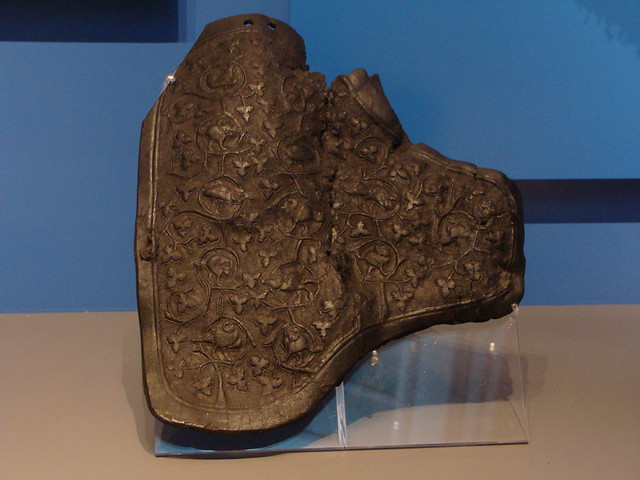Hi, welcome to the boards!
FortPwnall wrote:So, if I'm understanding this correctly, if I slice someone who is wearing a maille coif on the head with a greatsword, all of the slicing damage is converted directly to bashing damage? Whereas if I hit someone wearing a padded coif, it just counts as slicing damage of the same amount?
Correct. Keep in mind you still reduce the damage by the armor amount, so if you got hit by a 5 damage attack the maille coif would reduce it to a level 2 blunt and the padded coif would take a level 3 cutting wound.
FortPwnall wrote:I get that a greatsword can cause some serious blunt force trauma, but is its damage not primarily due to the fact that it is cutting? Should it really be doing the same amount of blunt damage as it would have done cutting damage?
Yes, a lot of the damage comes from the cut. That's why the damage is capped at level 3. And the draw cut maneuver deals additional damage which is negated by the metal armor.
FortPwnall wrote:Does the damage table make up for this? I.e., is a slice-wound more serious than a similar level bash-wound?
Yes, blunt is considerably worse. In general, cutting will give a higher TN modifier and result in bleeding. Here's the level 3 crown wounds for example:
BLUNT:
Impact 6, TN4
Mild concussion. Ears ringing, bad headache and dizziness. Some blood in the hair. KO3
CUTTING
Impact 6, TN5
Flap of loose scalp or deeper cut with skull intact. Dizziness and bleeding. BL1, KO3
Also, the level 5 cutting wounds result in dismemberment. The blunt level 5s can (sometimes) be recovered from.
FortPwnall wrote:But if so, shouldn't bludgeoning weapons be doing more damage in general to compensate?
Why do you think they need it? The damage types have been designed so that generally, Cutting > Piercing > Blunt. They are balanced by the fact that Cutting is the most damaging type but is also the easiest to negate. Blunt is the weakest type but cannot effectively be countered. Piercing straddles between the two in effectiveness and applicability.
FortPwnall wrote:It seems that any bashing weapon worth its salt in the table has the crushing quality anyway, but if I bash you really hard with something that doesn't have this quality, like say I bash you with a quarterstaff on your boiled leather cap, then the damage gets capped? Like, my quarterstaff is incapable of smashing through your cap? I don't know much about boiled leather, but since it is "akin to hard plastic sporting pads" I guess I can understand it being impossible without using a "crushing" weapon?
Correct, a blunt attack without the crushing property is capped at level 3 against rigid armor. As you can see above though, a level 3 blunt wound to the head is enough to force your target to pass a K.O. test or fall unconscious. So your quarter staff could still knock your target out, effectively winning the combat in a single blow. You just can't completely cave their head in like a weapon with Crushing could.
FortPwnall wrote:Furthermore, the rules say that any time a character manages to suffer a level 4 or 5 wound through their armor, it’s assumed that that location on their armor has been damaged. Does the cap get calculated before this rule apply? Does it actually mean it is impossible to damage e.g. metal plate with a quarterstaff or greatsword? This is an entirely believable proposition, to be honest. It also implies it is impossible to damage boiled leather similarly. But the rules as-written don't make it terribly clear.
That's an interesting question. I imagine it will be considered after the wound is reduced but you will have to get Agamemnon or higgins to give the final word on that.
FortPwnall wrote:So... one suggestion I'd have is to do the following. Have two properties as follows:
"Maille: Converts all slashing and piercing damage to blunt and subtracts 1 from such converted damage."
"Plate: Converts all slashing and piercing damage to blunt and subtracts 1 from such converted damage, and then also caps all converted blunt damage at 3 (after subtraction)."
Why wouldn't you just increase the AV of all metal armor by 1? It's identical in effect but requires less math.
The full damage formula is Wound Level = Weapon DR + Attack MOS + Attackers BTV - Defenders BTV - Armor AV
All the maille and plate armors are already mitigating more damage than the non metal armors.
FortPwnall wrote:This essentially removes the need for the "crushing" property, since it seems that everything in the weapons table that does bashing damage basically already has crushing, except Bec de Corbin which has plate piercing anyway... and the wooden club, for which you could perhaps specify as a property of the club (i.e., club damage vs plate is capped at 3) if you want.
Most weapons intended for Blunt attacks do get Crushing. The difference comes when you are considering attacks that were originally cutting and are converted to blunt won't ever have crushing. You need some way to delineate between a MOS5 sword attack that is converted to blunt and a MOS5 mace attack. If the mace has crushing, it will deal full damage but the sword will still be capped.
If you dig around in this thread, you will find some more explanations as to why things were designed this way.
viewtopic.php?f=13&t=373
But basically, here's the TLDR version:
Agamemnon wrote:Our rules weren't drawn up in a vacuum. There was an exhaustive amount of research that went into figuring out how the historical bits fit together, particularly where armor and weapons were concerned. I've got a shelf full of books and historical accounts, we have a folder somewhere of pdfs. We've talked to a number of people who are experts on the actual subject in question, whose job is literally studying, recreating, testing, and writing about this stuff. After talking to them, we came to certain conclusions that formed the basis of the rules.
No historical man-sized weapon wielded with man-sized force is going to meaningfully cut into a steel breastplate. At best, you're going to put a decent-sized dent in it. Even against iron, the result is a slightly larger dent. This is a limit imposed by the fact that you are banging tempered iron against tempered iron. Physics doesn't care how much you can bench, you aren't going to produce enough acceleration to make that work.
Piercing plate is extremely difficult short of a weapon whose geometry is explicitly designed to pierce plate. You can usually tell when you see them, because they are generally shaped like railroad spikes. You're talking about something like a spike on a polearm or the beaked end of a warhammer. I've seen plenty of questionable tests in which someone "pierced" a suit of plate armor with a sword. None of these tests that I've seen have disclosed the gauge or type of steel that the pierced armor was made from, and in none of these cases has the blade gone deeply enough into the plate to meaningfully pierce the person through the padding that would have been below. Further, we have plenty of historical accounts of the efficacy of armor, particularly plate. After (I believe it was) Agincourt, there were french knights laying exhausted and helpless in the mud and unable to defend themselves. The soldiers that dispatched them had to pry open their visors and thrust daggers through the knight's eyes because the soldiers were having trouble finding a significant gaps in the plate.
No historical man-sized weapon is going to cut or chop through riveted maille (as was used nigh-universally throughout Europe). You absolutely can bust a few links with a particularly good strike from a particularly heavy weapon, but you aren't going to cut through the maille and through someone's arm beneath it. The breaking links themselves help function the same way modern day ballistic plates do -- the act of breaking the ring helps disperse the force. You'll break the dude's sternum, but you won't bust enough links to make a big enough hole through the maille to push the blade of the weapon through AND then also cut through the padding beneath AND THEN also into their chest beneath it. Like with plate, if you're not piercing it the goal is to deliver blunt trauma through it. Hell, cutting into a historical gambeson isn't a particularly easy task on its own.
Piercing maille is somewhat easier, but still very difficult unless you have a weapon whose geometry is explicitly designed for piercing it. Maille-piercing weapons still aren't "cutting" through maille, they are designed to get into the gaps of rings and burst them. This is why later swords became so drastically tapered and diamond cross-sections became the norm. They needed the sharp point and rigid geometry to help needle their way in and bust the rivets open so the blade can penetrate.
Armor is very, very good at what it does. So good, in fact, that soldiers have been willing to bear the weight, heat, and overwhelming expense of it in one form or another for the fifteen hundred years or so our game can easily cover. The more Higgins and I have researched it, the more HEMA people and historian-types we've talked to, the more the above seems to ring true. There are always outliers and stories about this or that person this one time getting his helmet cut in half by an axe, but we never see evidence of this in the archeology, this isn't what's written in the manuals by people of the period, and never seems to bear out in testing with period-correct materials. I'm perfectly comfortable chalking these outlying cases up to a combination of malfunctioning equipment, bad steel, or just outright hyperbole. The Norse talk about swords that can cut through rocks and trees in a single blow. I've heard rumors about Japanese soldiers cutting through machine-gun barrels, too.
People have been riding their own hype-trains for literally as long as we have been communicating as a species. I am sure if you could go back to the Pleistocene you'll find someone who will brag that their flint-knapped spear was so sharp, their aim so true, and their arm so powerful that they threw it clean through one side of a mastodon and out the other side, felling the beast in a single blow. That man's tribe mates will roll their eyes and give the dude shit for it, but after he dies that'll be the story they tell because it's how they want to remember him.
Are there fringe cases? Sure. But we put a huge amount of resources into modeling the combat as it is. I don't see a benefit in modeling metallurgical impurities, botched tempering, and the effects of entropy on armor. I've run our work past professional academics and active-HEMA types alike. I'm perfectly comfortable going with their stamp of realism. At the end of the day, "playable game" is a higher priority than "detailed simulation of every possible factor."





